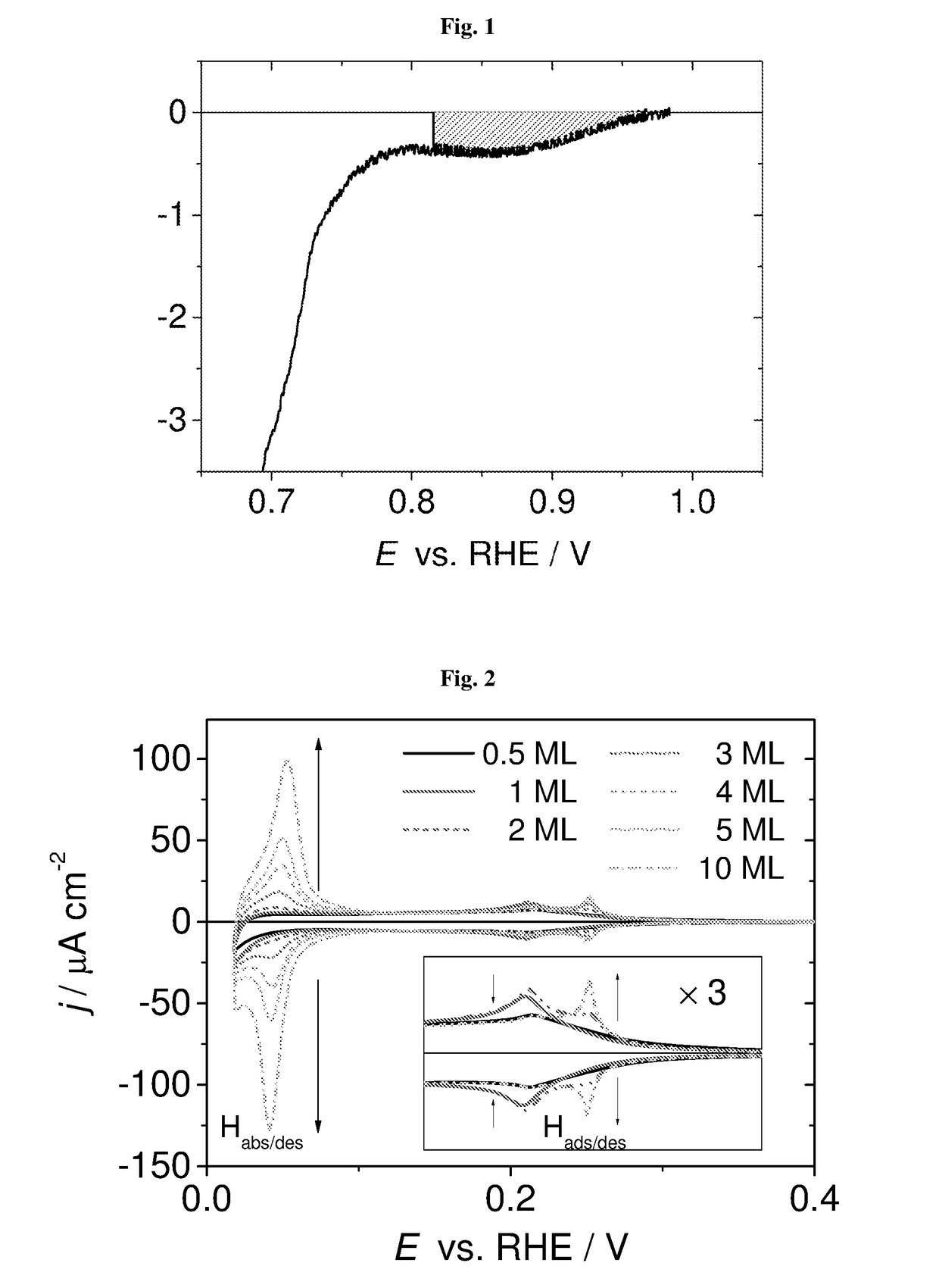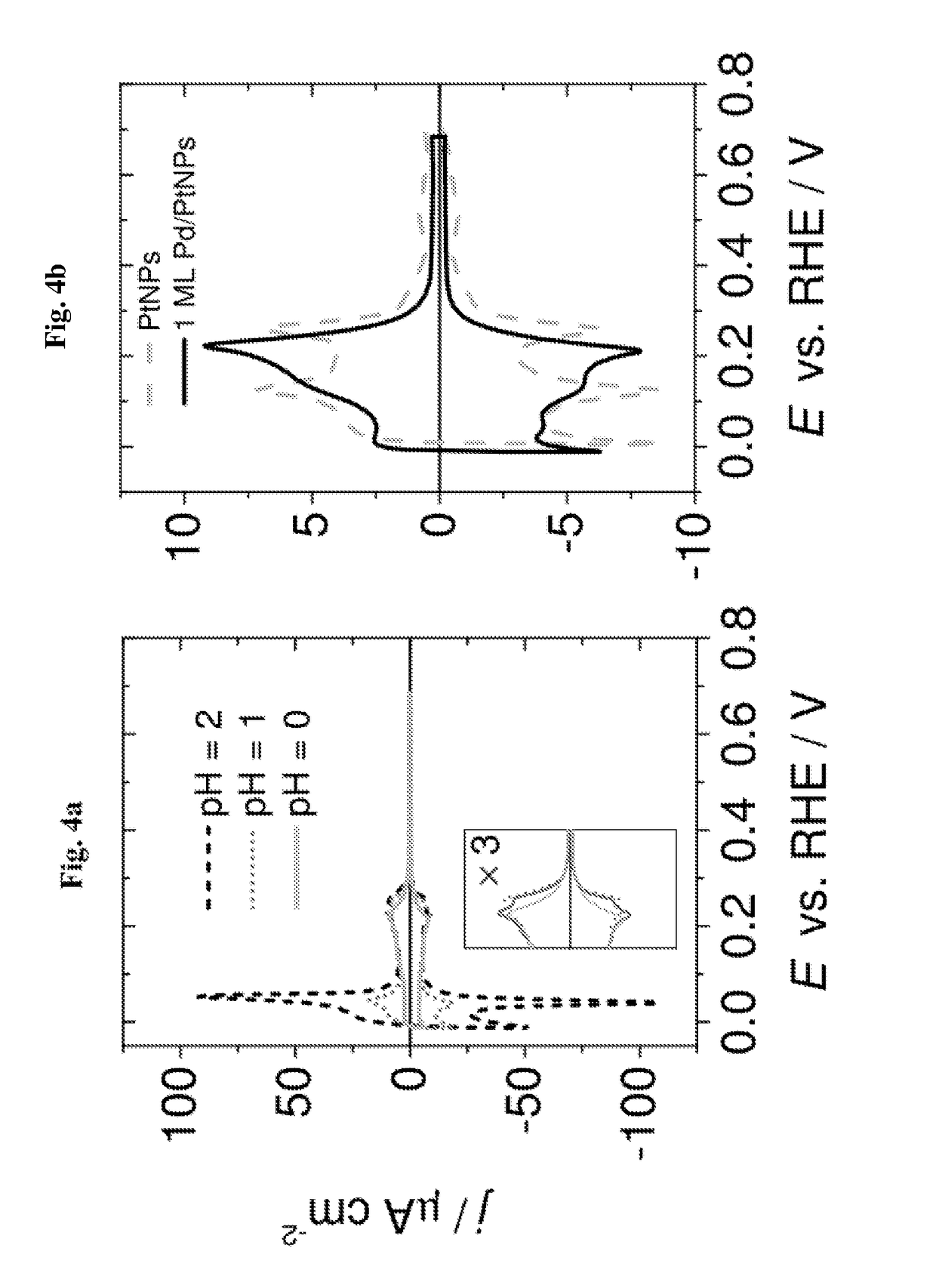Means for carrying out electroless metal deposition with atomic sub-monolayer precision
- Summary
- Abstract
- Description
- Claims
- Application Information
AI Technical Summary
Benefits of technology
Problems solved by technology
Method used
Image
Examples
example 1
Control of the Plating Solution by Means of Redox Buffer
[0058]The aim of this study was to verify whether it is possible to control potential of the plating solution by means of the redox buffer. For this purpose aqueous solutions of 1.5 M hydrogen peroxide was used. The dependence of platinum electrode potentials in function of solution pH was determined by open circuit measurements. The potential was adjusted by using 0.2 M acetic buffer and / or 0.2 M phosphoric buffer. To maintain pH<1 sulfuric acid was used. The results are shown in the FIG. 3.
[0059]The electrode potentials are in linear dependence with pH of the solution with the slope 0.043 and 0.056 mV per decade concentration for pH higher and lower than 4, respectively. Based on the linear fitting of experimental results, the potentials of plating solutions with different pH values can be presented as E / V=−0.040·pH+0.825 for pH lower than 3.5, and E / V=−0.056·pH+0.894 for pH's value higher than 4.5.
[0060]Although platinum cat...
example 2
ss Deposition of Palladium on Platinum Nanoparticles
[0061]Palladium deposition in the presence of hydrogen peroxide may be described with the following equation (in appropriate pH):
Pd2++H2O2→O2+Pd+2H+
During oxidation of hydrogen peroxide into a gaseous oxygen, the plating solution potential value is constant, because H2O2 is used in excess.
[0062]In all cases the monolayer deposition was carried out in the same way. 1.5 M hydrogen peroxide was used as a redox buffer. When the exact potential value necessary for deposition of a metal monolayer on a substrate is determined, the pH of the plating solution is calculated and adjusted accordingly.
[0063]The electroless deposition of Pd on Pt nanoparticles was carried out at different pH values: 0, 1 and 2, as well as for different PdCl42− concentrations: 50 μm, 100 μm, 200 μm and 400 μM. In each case the electroless deposition of Pd on Pt nanoparticles was carried out for 2 hours.
[0064]The core-shell Pt / Pd nanoparticles obtained as describe...
example 3
ss Deposition of Silver on Palladium Nanoparticles
[0075]Electroless deposition of Ag on Pd nanoparticles was carried out as described above from the plating solution comprising 1.5 M of H2O2 and 2 mM Ag+ at pH=4 (0.2 M acetic buffer). Deposition was carried out for 4 hours in the controlled temperature of 20° C.
[0076]On FIG. 8 cyclic voltammograms recorded at 5 mV·s−1 for pure 10 nm Pd nanoparticles (PdNPs) (dashed line) and core-shell nanoparticles Pd / Ag (Ag@PdNPs) (solid line) are compared. No cathodic current peak at E=0.29, i.e. the peak attributed to hydrogen adsorption, can be observed on the cyclic voltammogram recorded for Pd / Ag core-shell nanoparticles. It means that the surface of Pd nanoparticles is entirely covered by silver atoms. However, this layer is so thin that it is permeable to hydrogen absorption. The later can be deduced from the cathodic current decrease and corresponding anodic current peak at E=0.2 V. A more significant peaks separation is related to slower ...
PUM
| Property | Measurement | Unit |
|---|---|---|
| Concentration | aaaaa | aaaaa |
Abstract
Description
Claims
Application Information
 Login to View More
Login to View More - R&D
- Intellectual Property
- Life Sciences
- Materials
- Tech Scout
- Unparalleled Data Quality
- Higher Quality Content
- 60% Fewer Hallucinations
Browse by: Latest US Patents, China's latest patents, Technical Efficacy Thesaurus, Application Domain, Technology Topic, Popular Technical Reports.
© 2025 PatSnap. All rights reserved.Legal|Privacy policy|Modern Slavery Act Transparency Statement|Sitemap|About US| Contact US: help@patsnap.com



